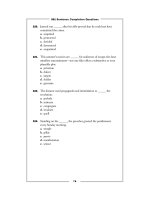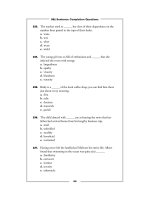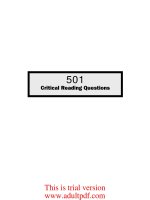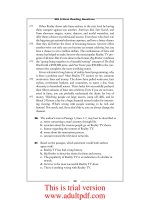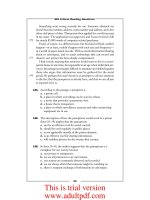501 critical reading questions p12
Bạn đang xem bản rút gọn của tài liệu. Xem và tải ngay bản đầy đủ của tài liệu tại đây (137.62 KB, 15 trang )
(5)
(10)
(15)
(20)
(25)
(30)
(35)
(40)
of Americans willing to ingest capsules of pulverized
garlic or other herbal supplements in the name of health.
Complementary and alternative medicine (CAM), which
includes a range of practices outside of conventional
medicine such as herbs, homeopathy, massage, yoga,
and acupuncture, holds increasing appeal for Americans.
In fact, according to one estimate, 42% of Americans
have used alternative therapies. A Harvard Medical School
survey found that young adults (those born between
1965 and 1979) are the most likely to use alternative
treatments, whereas people born before 1945 are the least
likely to use these therapies. Nonetheless, in all age
groups, the use of unconventional healthcare practices
has steadily increased since the 1950s, and the trend is
likely to continue. CAM has become a big business as
Americans dip into their wallets to pay for alternative
treatments. A 1997 American Medical Associa- tion study
estimated that the public spent $21.2 billion for alternative
medicine therapies in that year, more than half of which
were “out-of- pocket” expenditures, meaning they were not
covered by health insur- ance. Indeed, Americans made
more out-of-pocket expenditures for alternative services
than they did for out-of-pocket payments for hos- pital
stays in 1997. In addition, the number of total visits to
alterna- tive medicine providers (about 629 million)
exceeded the tally of visits
to primary care physicians (386 million) in that year.
However, the public has not abandoned conventional
medicine for alternative healthcare. Most Americans seek
out alternative therapies as a complement to their
conventional healthcare whereas only a small percentage of
Americans rely primarily on alternative care. Why have so
many patients turned to alternative therapies? Frustrated
by the time constraints of managed care and alienated by
conventional med- icine’s focus on technology, some feel
that a holistic approach to healthcare better reflects their
beliefs and values. Others seek thera- pies that will
relieve symptoms associated with chronic disease, symptoms that mainstream medicine cannot treat.
Some alternative therapies have crossed the line into
mainstream medicine as scientific investigation has
confirmed their safety and effi- cacy. For example, today
physicians may prescribe acupuncture for pain
management or to control the nausea associated with
chemother- apy. Most U.S. medical schools teach courses
in alternative therapies and many health insurance
companies offer some alternative medicine benefits. Yet,
despite their gaining acceptance, the majority of alternative therapies have not been researched in controlled
studies. New research efforts aim at testing alternative
methods and providing the
107
501 Critical Reading Questions
(45)
(50)
public with information about which are safe and effective
and which are a waste of money, or possibly dangerous.
So what about those who swear by the health benefits of
the “smelly rose,” garlic?
Observational studies that track disease incidence in
different pop- ulations suggest that garlic use in the diet
may act as a cancer-fighting agent, particularly for
prostate and stomach cancer. However, these findings
have not been confirmed in clinical studies. And yes,
reported side effects include garlic odor.
180. The author’s primary purpose in the passage is to
a. confirm the safety and effectiveness of alternative
medicine approaches.
b. convey the excitement of crossing new medical frontiers.
c. describe the recent increase in the use of alternative
therapies.
d. explore the variety of practices that fall into the
category of alternative medicine.
e. criticize the use of alternative therapies that have
not been sci- entifically tested.
181. The author describes wearing garlic (line 1) as an example of
a. an arcane practice considered odd and superstitious today.
b. the ludicrous nature of complementary and
alternative medicine.
c. a scientifically tested medical practice.
d. a socially unacceptable style of jewelry.
e. a safe and reliable means to prevent some forms of cancer.
182. The word conventional as it is used in line 7 most nearly means
a.
b.
c.
d.
e.
appropriate.
established.
formal.
moralistic.
reactionary.
108
501 Critical Reading Questions
183. The author most likely uses the Harvard survey
results (lines 10–13) to imply that
a. as people age they always become more conservative.
b. people born before 1945 view alternative therapies with disdain.
c. the survey did not question baby boomers (those
born between 1945–1965) on the topic.
d. many young adults are open-minded to alternative therapies.
e. the use of alternative therapies will decline as
those born between 1965 and 1979 age.
184. The statistic comparing total visits to alternative
medicine practitioners with those to primary care
physicians (lines 23–25) is used to illustrate the
a. popularity of alternative medicine.
b. public’s distrust of conventional healthcare.
c. accessibility of alternative medicine.
d. affordability of alternative therapies.
e. ineffectiveness of most primary care physicians.
185. In line 28, complement most nearly means
a.
b.
c.
d.
e.
tribute.
commendation.
replacement.
substitute.
addition.
186. The information in lines 30–35 indicates that
Americans believe that conventional healthcare
a. offers the best relief from the effects of chronic diseases.
b. should not use technology in treating illness.
c. combines caring for the body with caring for the spirit.
d. falls short of their expectations in some aspects.
e. needs a complete overhaul to become an effective system.
109
501 Critical Reading Questions
187. The author suggests that cross[ing] tfte line into mainstream
medicine
(lines 36–37) involves
a. performing stringently controlled research on
alternative therapies.
b. accepting the spiritual dimension of preventing and
treating illness.
c. approving of any treatments that a patient is
interested in trying.
d. recognizing the popularity of alternative therapies.
e. notifying your physician about herbs or alternative
therapies you are using.
188. In lines 49–54, the author refers to garlic use again in order to
a.
b.
c.
d.
cite an example of the fraudulent claims of herbal supplements.
suggest that claims about some herbs may be legitimate.
mock people who take garlic capsules.
reason why some Americans are drawn to
alternative health methods.
e. argue that observational studies provide enough evidence.
189. Which of the following best describes the
approach of the passage?
a. matter-of-fact narration
b. historical analysis
c. sarcastic criticism
d. playful reporting
e. impassioned argument
Questions 223–232 are based on the following
passage.
In the following article, the author speculates about a connection between
the low-fat, high-carbohydrate diet recommended by the medical
establishment in the last twenty years and the increasing rate of obesity
among Americans.
(1)
(5)
American dietitians and members of the medical
community have ridiculed low-carbohydrate diets as
quackery for the past thirty years, while extolling a diet
that cuts down on fat, limits meat consumption, and
relies on carbohydrates as its staple. Many Americans
are famil- iar with the food pyramid promoted by the U.S.
government, with its foundation of carbohydrates such
as breads, rice, and pasta, and its apex allotted to fats,
oils, and sweets. Adhering to the government’s
110
501 Critical Reading Questions
(10)
(15)
(20)
(25)
(30)
(35)
(40)
(45)
anti-fat, pro-carbohydrate gospel, food manufacturers have
pumped out fat-free grain products that lure consumers
with the promise of leaner days. Then, why are
Americans getting
so
fat? Could
the
dietary
recommendations of the last twenty years be wrong?
And what’s more, could the proponents of diets that push
protein and fat be rigftt?
Fact: Obesity rates have soared throughout the
country since the 1980s. The United States Centers of
Disease Control reports that the number of obese adults
has doubled in the last twenty years. The num- ber of
obese children and teenagers has almost tripled,
increasing 120% among African-American and Latino
children and 50% among white children. The risk for Type
2 diabetes, which is associ- ated with obesity, has
increased dramatically as well. Disturbingly, the disease
now affects 25% to 30% of children, compared with 3%
to 5% two decades ago.
What is behind this trend? Supersized portions, cheap
fast food, and soft drinks combined with a sedentary
lifestyle of TV watching or Internet surfing have most likely
contributed to the rapid rise of obesity. Yet, there might
be more to it: is it a coincidence that obesity rates
increased in the last twenty years—the same time period
in which the low-fat dietary doctrine has reigned? Before
the 1980s, the conventional wisdom was that fat and
protein created a feeling of satiation, so that overeating
would be less likely. Carbohydrates, on the other hand,
were regarded as a recipe for stoutness. This perception
began to change after World War II when coronary heart
disease reached near epidemic proportions among
middle-aged men. A theory that dietary fat might increase
cholesterol levels and, in turn, increase the risk of heart
disease emerged in the 1950s and gained increasing
acceptance by the late 1970s. In 1979, the focus of the
food guidelines promoted by the United States Department of Agriculture (USDA) began to shift away from getting
enough nutrients to avoiding excess fat, saturated fat,
cholesterol, and sodium—the components believed to be
linked to heart disease. The anti-fat credo was born.
To date, the studies that have tried to link dietary fat to
increased risk of coronary heart disease have remained
ambiguous. Studies have shown that cholesterol-lowering
drugs help reduce the risk of heart disease, but whether
a diet low in cholesterol can do the same is still
questionable. While nutrition experts are debating whether
a low-fat, carbohydrate-based diet is the healthiest diet for
Americans, nearly all agree that the anti-fat message of
the last twenty years has been over- simplified. For
example, some fats and oils like those found in olive oil
111
501 Critical Reading Questions
(50)
(55)
(60)
(65)
and nuts are beneficial to the heart and may deserve a
larger propor- tion in the American diet than their place
at the tip of the food pyra- mid indicates. Likewise, some
carbohydrates that form the basis of the food pyramid, like
the “refined” carbohydrates contained in white bread,
pasta, and white rice, are metabolized in the body much
the same way sweets are. According to one Harvard
Medical School researcher, a breakfast of a bagel with
low-fat cream cheese is “meta- bolically indistinguishable
from a bowl of sugar.”
So what about those high-fat, protein diets that restrict
carbohy- drates like the popular Atkins’ diet and others? A
small group of nutri- tion experts within the medical
establishment find it hard to ignore the anecdotal evidence
that many lose weight successfully on these diets. They are
arguing that those diets should not be dismissed out of
hand, but researched and tested more closely. Still others
fear that Ameri- cans, hungry to find a weight-loss
regimen, may embrace a diet that has no long-term data
about whether it works or is safe. What is clear is that
Americans are awaiting answers and in the meantime, we
need to eat sometfting.
223. The passage is primarily concerned with
a. questioning the dietary advice of the past two decades.
b. contrasting theories of good nutrition.
c. displaying the variety of ways one can interpret
scientific evidence.
d. debunking the value of diets that restrict carbohydrates.
e. isolating the cause of the rising rate of obesity.
224. The author’s attitude toward the medical experts who
ridiculed low- carboftydrate diets as quackery and praised
low-fat diets is one of
a. bemused agreement.
b. seeming ambivalence.
c. unconcerned apathy.
d. implicit objection.
e. shocked disbelief.
225. The term gospel (line 8) as it is used in the passage
most nearly means
a. one of the first four New Testament books.
b. a proven principle.
c. a message accepted as truth.
d. American evangelical music.
e. a singular interpretation.
112
501 Critical Reading Questions
226. The author uses the word Fact (line 14) in order to
a.
b.
c.
d.
e.
draw a conclusion about the USDA’s dietary recommendations.
imply that statistical information can be misleading.
hypothesize about the health effects of high-fat, protein diets.
introduce a theory about the increased rate of obesity.
emphasize a statistical reality regardless of its cause.
227. The passage suggests that the obesity trend in the United States
is
a.
b.
c.
d.
e.
partly a result of inactive lifestyles.
the predictable outcome of cutting down on saturated fat.
a cyclical event that happens every twenty years.
unrelated to a rise in diabetes cases.
the unfortunate byproduct of the effort to reduce heart
disease.
228. In lines 26–31, the author implies that the
government’s 1979 food guidelines
a. relied more on folk wisdom than on scientific study.
b. was based on the theoretical premise that eating
less dietary fat reduces heart disease.
c. was negligent in not responding to the increasing
incidence of heart disease.
d. no longer bothered to mention nutrient objectives.
e. was successful in reducing heart disease rates.
229. The author characterizes the anti-fat message of tfte last twenty
years
(line 48) as
a. elusive.
b. questionable.
c. incoherent.
d. beneficial.
e. inventive.
230. The author cites the example of a breakfast of a
bagel witft low-fat cream cfteese in order to
a. show that getting a nutritional breakfast can
be fast and convenient.
b. demonstrate that carbohydrates are the ideal nutrient.
c. overturn the notion that a carbohydrate-based
breakfast is necessarily healthy.
d. persuade readers that they should eat eggs and sausage for
breakfast.
e. argue that Americans should greatly restrict their
carbohydrate intake.
113
501 Critical Reading Questions
231. The author of the passage would most likely agree
with which statement?
a. The federal government knowingly gave the public
misleading advice.
b. Soaring obesity rates are most certainly a result of low-fat diets.
c. Nutritionists should promote high-fat, protein
diets like the Atkin’s diet.
d. Scientists should investigate every fad diet with equal scrutiny.
e. There is no definitive evidence connecting dietary
fat to heart disease.
232. The tone of the last sentence of the passage
(lines 65–67) is one of
a. optimism.
b. resolve.
c. indulgence.
d. irony.
e. revulsion.
Answers
168 b. The passage states that daytime drowsiness, even
.
during
boring
activities
(lines 1–2), is a sign that a person is not
getting enough
sleep.
169 a. This image connotes a state of working hard without
.
adequate
rest.
170 e. The passage claims that lack of sleep magnifies alcoftol’s
.
effects(lines
on tfte
body
14–15) implying that it hampers a person’s
ability to
function.
171 d. The first paragraph of this short passage deals with the
.
symptoms
of sleep deprivation and the second paragraph discusses
the dangers
of not getting enough sleep. Choices b and e are
toobe
specific
to
the passage’s primary purpose. Choices a and c
are notby
supported
the passage.
172 d. Although he was a man of no formal scientific
.
education (line
2),
Leeuwenhoek
demonstrated,
in his own words, a
craving afterwfticft I notice resides in me more tftan in
knowledge,
most otfter
men
(lines
24–26),
who was the first to describe
microorganisms.
phrase
stumbled The
upon in choice a is too accidental to
describe
Leeuwenhoek’s perseverance. The words proficient and
entertainment in choice c do not accurately describe
Leeuwenhoek’s skill
114
501 Critical Reading Questions
and drive depicted in the passage. Choices b and e
are incorrect; Leeuwenhoek was not trained nor did
he know that his discover- ies would later help to cure
disease.
173. c. Inspired means to exert an animating or enlivening
influence on. In the context of the passage,
Leeuwenhoek’s creation of microscope lenses were
influenced by the lenses used by drapers.
174. a. The quotation highlights the value Leeuwenhoek
placed on shar- ing his discoveries with other
scientists. He states that he tftougftt it was my duty
to put down my discovery on paper, so tftat all
ingenious people migftt be informed tftereof (lines 27–
28).
175. b. The tone of the passage is positive. However,
ecstatic reverence (choice a) is too positive and
tepid approval (choice c) is not positive enough.
176. c. Nowhere in the passage does the author speculate
about whether teenagers can change their exercise
habits.
177. c. One meaning of sedentary is settled; another
meaning is doing or requiring much sitting.
Stationary, defined as fixed in a course or mode, is
closest in meaning.
178. e. The last sentence illustrates factors that motivate
teenagers to exercise by using the results of a
national survey to provide spe- cific examples.
179. d. The passage promotes change in teenagers’
exercise habits by emphasizing the benefits of
exercise, the moderate amount of exercise needed
to achieve benefits, and some factors that may
encourage teenagers to exercise.
180. c. The focus of the passage is Blackwell’s efforts to
open the profes- sion of medicine to women. Lines 3–
4 state that Blackwell sup- ported women’s medical
education and ftelped many otfter women’s careers.
181. a. In this context, the word practical refers to the
solution’s utility as opposed to its theoretical or ideal
premise.
182. b. The author suggests that Samuel Blackwell’s belief
in slaves’ rights influenced Elizabeth’s struggle for
greater rights for women.
183. e. Blackwell wrote that the study of medicne filled me witft
disgust
(line 22).
184. b. Although Blackwell did overcome her revulsion of
the body, pro- vide healthcare to the poor, and
establish a medical college for women, she did not
chose medicine for these reasons according to the
passage. Blackwell was told her goal was impossible (line
29), too expensive (line 29) and that medical
education was not available to women (line 30).
115
501 Critical Reading Questions
185. e. The Geneva Medical College student body voted
“yes” on Black- well’s admittance as a joke (line 38).
186. b. Initially Blackwell was interested in teaching (line
23). Subse- quently, she was attracted by tfte
cftallenge (lines 31–32) and deter- mined to succeed
in studying and practicing medicine.
187. b. The question calls for an opinion. The passage
does not speculate about what degree of women’s
success can be attributed to Black- well’s influence.
188. b. The author uses the phrase going gray (line 1) as a
metaphor for growing older. It describes the
phenomenon of a large segment of a population
growing older.
189. c. The passage makes an argument for more geriatric
training based on statistical information and studies.
190. d. The passage emphasizes the need for age-specific care.
191. a. In this context, address most nearly means
manage, or treat. The sentence implies that some
kind of action is taken after the prob- lem has first
been identified, analyzed, and dissected.
192. c. Although choices a and b may be correct
statements, they do not reflect the author’s purpose in
citing the example of untreated depression in the
elderly. Choice d is incorrect and choice e is not
supported by the passage.
193. c. According to the passage, geriatric training
improves a healthcare provider’s ability to distinguisft
between “normal” cftaracteristics associ- ated witft
aging and illness (lines 58–59).
194. b. The author states that healthcare providers
should consider not only tfte pftysical but mental,
emotional, and social cftanges of tfte aging process
(lines 57–58).
195. d. The author’s sense of urgent recommendation is
expressed through the use of the helping verbs
must (lines 55 and 56) and sftould (line 60).
196. d. Choices a, b, and e are too specific to be the
primary purpose of the passage, whereas choice c is
too general. The passage focuses on the importance
of the first official report (line 27) to name smoking a
serious health hazard.
197. c. One meaning of preoccupied is lost in thought;
another is engaged or engrossed. In this case,
absorbed is nearest in meaning.
198. a. The debate over tfte ftazards and benefits of
smoking (line 6) that con- tinued since the sixteentft
century (line 9) points to a long-standing controversy.
199. e. An alliance of prominent private ftealtft
organizations (line 28) gave the push for an official
report on smoking.
200. d. The quotation illustrates the response to the
report, describing its effect on the country as a
bombsftell (line 48).
116


